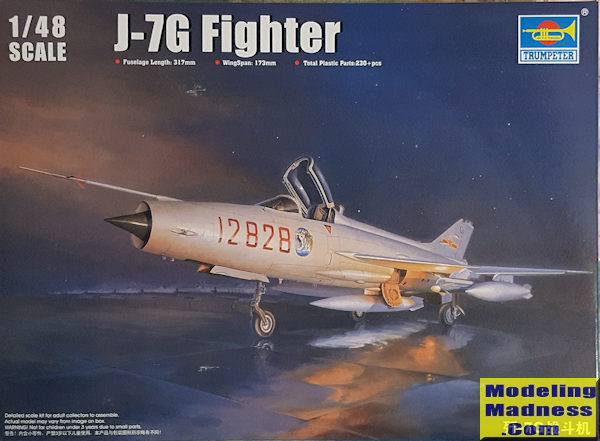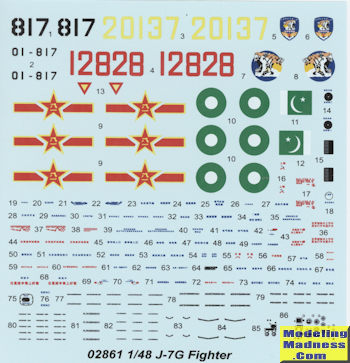
| KIT #: | 02861 |
| PRICE: | $43.99 SRP |
| DECALS: | Three options |
| REVIEWER: | Scott Van Aken |
| NOTES: | 2015 release |

| HISTORY |
The Chengdu J-7 (Chinese: 歼-7; third generation export version F-7; NATO Code: Fishbed) is a People's Republic of China license-built version[1] of the Soviet Mikoyan-Gurevich MiG-21. Though production ceased in 2013, it continues to serve, mostly as an interceptor, in several air forces, including the People's Liberation Army Air Force. The J-7 was extensively re-developed into the CAC/PAC JF-17 Thunder, which became a successor to the type.
The J-7G features a Chinese-made KLJ-6E radar, which has replaced the French-made Selex Galileo Grifo 7 radar featured on earlier models of the J-7 such as those which were exported to Namibia and Nigeria in 2009 and 2010 respectively. The G variant also has a 'cranked' wing of greater span than the standard MiG-21 or earlier J-7 versions. One of the main reasons for basing the J-7 on the very early MiG-21F was that it was the version initially built by the Chinese before Soviet/Chinese relations soured in the 1970s. The F version was also faster and more maneuverable than later versions due to its lighter weight. Though the type is now obsolete for more modern air arms, it provides an economical aircraft that is easier to maintain and operate. This is perfect for smaller air forces.
| THE KIT |
 From
what I gather, this kit was released in 2015 and is the only 1/48 kit of which I
am aware that builds into the last F-7 version, the G with the extended wing.
Molding is excellent and whatever complaints one has about Trumpeter kits, they
cannot really fault the quality of the molds.
From
what I gather, this kit was released in 2015 and is the only 1/48 kit of which I
am aware that builds into the last F-7 version, the G with the extended wing.
Molding is excellent and whatever complaints one has about Trumpeter kits, they
cannot really fault the quality of the molds.
The box is pretty well packed with sprues and you won't use all the parts provided. I'm sure most of these bits are also applicable to the standard MiG-21F and the other J-7 versions. Interestingly, the build starts with the nose gear well. All of the gear wells (called 'cabins' in the instructions. have to be built up of many parts and I found it interesting that the color indicated for these is a light blue. Also interesting is that they provide no color at all for the cockpit or the bang seat. Photos on the Internet show it to be a pretty standard Russian blue-green shade or a sort of brownish light grey. I'd go with the previous.
There is no indication for a need for nose weight, but I'd put in a bit just in case. A neat option is a detailed radio section under the upper nose panel, but most of us will simply glue the pane shut as it has no hinge. When one glues the fuselage halves, it traps both the intake shock cone and a built up tailpipe section. The fin has a separate rudder and two of the p.e. antennae fit on the side of the fin (you can also use the plastic ones). These seem to be the only photo etch bits used from the fret. The tail cone is a right and left half. I would have preferred this to be a single piece and Trumpeter should have the technology to make this so.
On the underside of the fuselage, there are a number of things to add. Both the forward and rear air brakes are separate and can be posed lowered. A cannon and its housing are also installed on the bottom. Another quirk is that when it comes to installing the cannon parts and forward speed brakes, the drawing shows only the far side having these bits attached. Would it not have been more logical to have this shown on the side facing the builder?
Wings are upper and lower halves with a non-positionable slat. The ailerons and flaps are molded in with the wings. This is correct as you will not see these normally deflected when the plane is on the ground. These items are molded in with the upper wing halves. The single piece tailplanes just slot into the fuselage. Landing gear is well done as are the gear doors. The instructions have you install the nose gear at the very start of the build, but I'd see if this could possibly be delayed until near the end. All of the tires are rubber/vinyl so if you don't like using these, get aftermarket. The canopy, windscreen and rear section are separate, but shown installed in the closed position. The canopy opens to the right side so you can position it as such, though it will be a butt join.
For things under wings we have a variety of air to air
missiles. There are two fuel tanks, but since you'll perhaps be using one for
the centerline, the plane w ill
have a full missile weapons load. Should you decide not to install the
centerline tank, the two fuel tanks will fit on the outer pylons as is the norm
with other MiG-21s. Missile options includes RS-3, PL-5/6/7/9, so you have
several to choose from.
ill
have a full missile weapons load. Should you decide not to install the
centerline tank, the two fuel tanks will fit on the outer pylons as is the norm
with other MiG-21s. Missile options includes RS-3, PL-5/6/7/9, so you have
several to choose from.
Instructions are well drawn, though have their idiosyncrasies. Any paints mentioned are either generic or Gunze. Markings are for three planes. One is the box art plane in an overall light grey. Interestingly, the full color painting and markings diagram shows the gear wells painted in a darkish green. Another Chinese plane is shown in a darker grey with a Pakistani plane in two greys such as you'd see on an F-16. The painting and markings guide shows a variety of manufacturers for colors. The decal sheet is nicely printed and glossy. The yellows look like they'd disappear on a darkish background, but use will tell if this is true or not.
| CONCLUSIONS |
If you are a MiG-21 fan, you will want to have this one in your collection. Not only is the wing a bit different, but it is an interesting mixture of old and new technology. Since the type is used by some interesting smaller air forces, it would be nice to have some aftermarket decals for it, but I know of none as of yet.
| REFERENCES |
https://en.wikipedia.org/wiki/Chengdu_J-7
October 2018
Copyright ModelingMadness.com. All rights reserved.
Thanks to me
for the preview kit. If you would like your product reviewed fairly and fairly quickly, please
contact
the editor or see other details in the
Note to
Contributors. Back to the Main Page
Back to the Review
Index Page
Back to the Previews Index Page